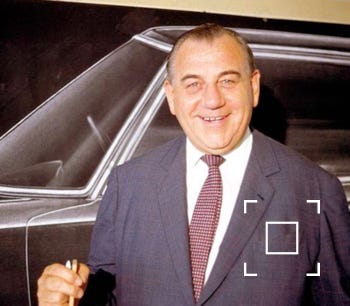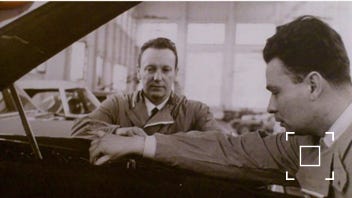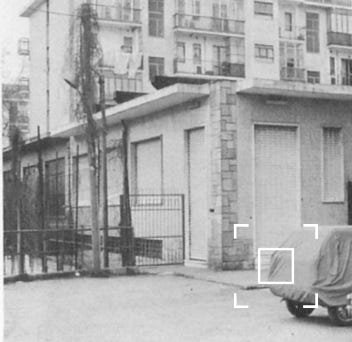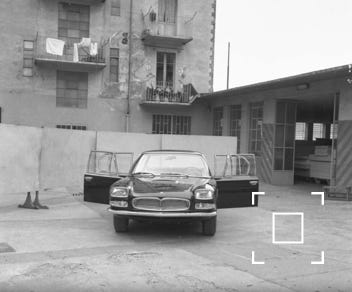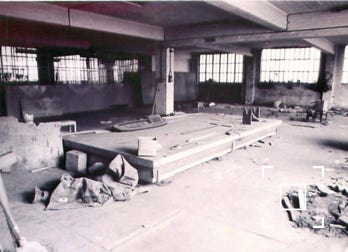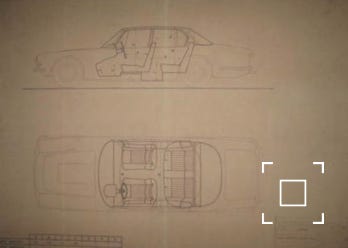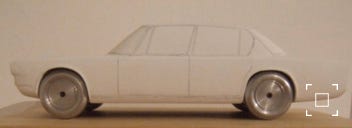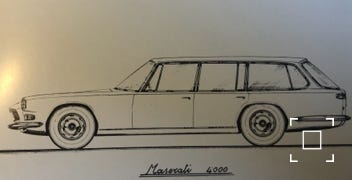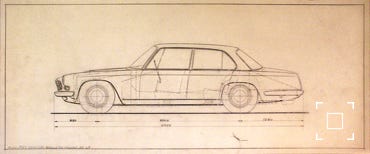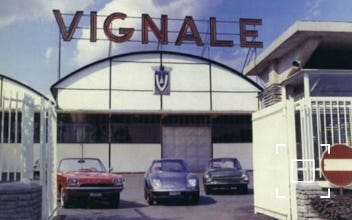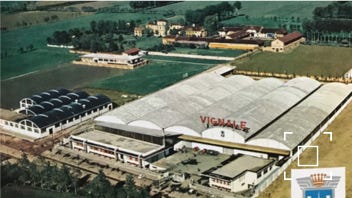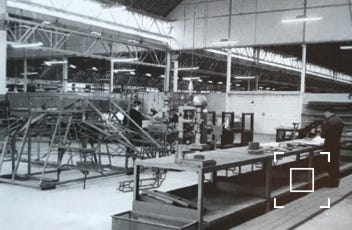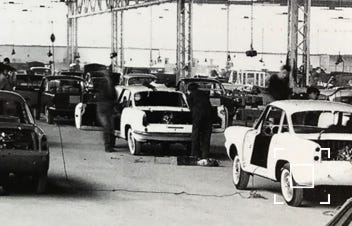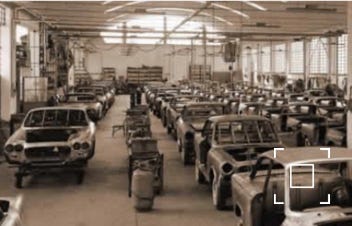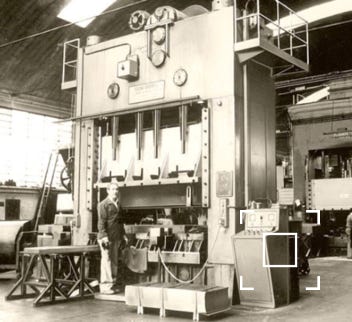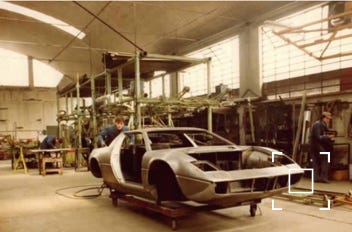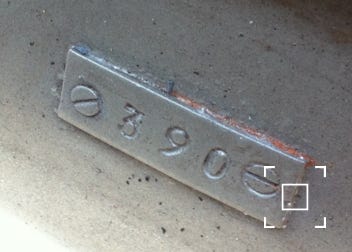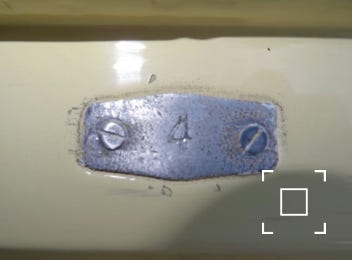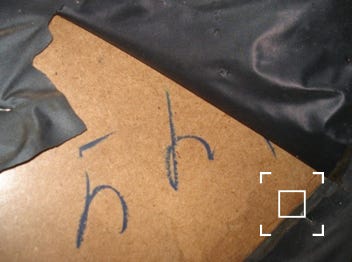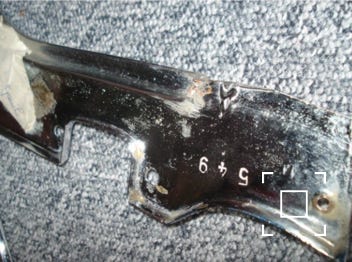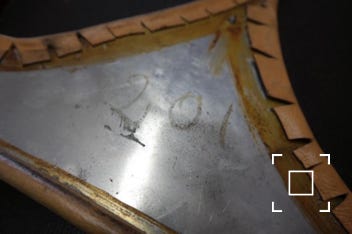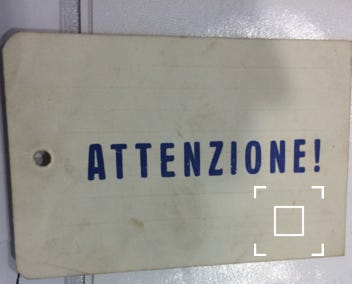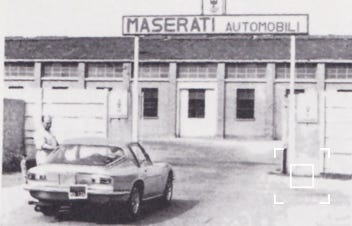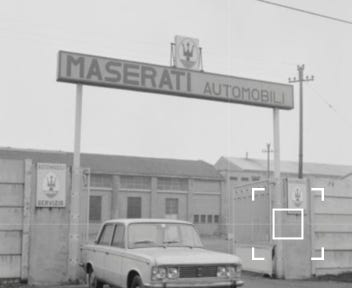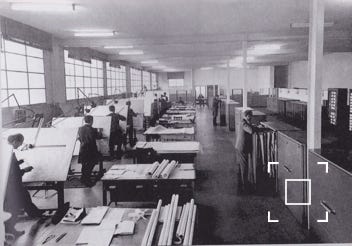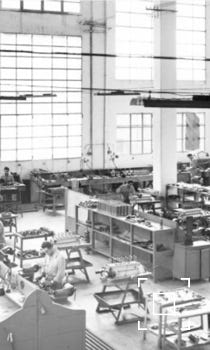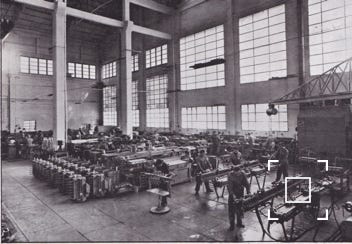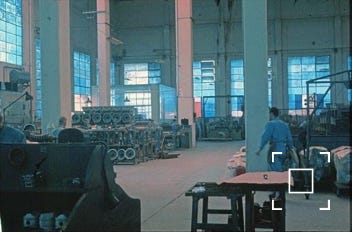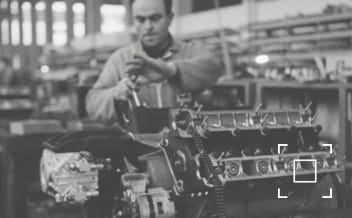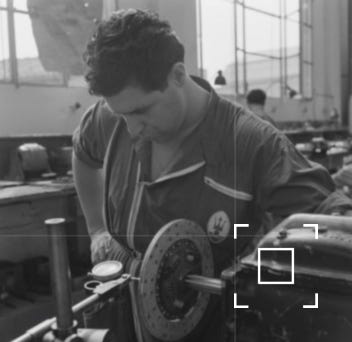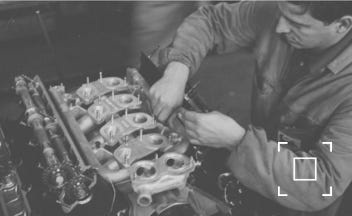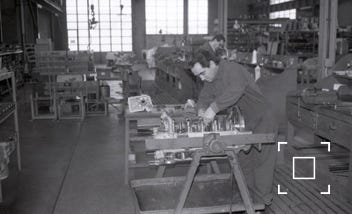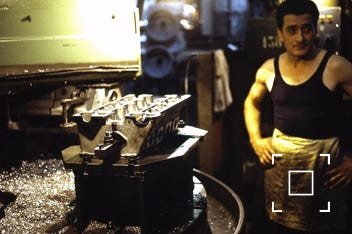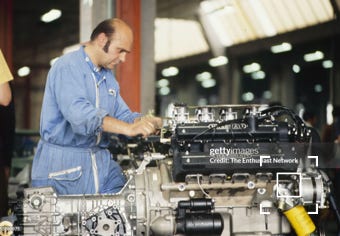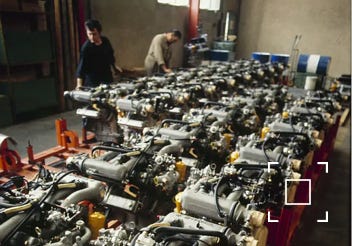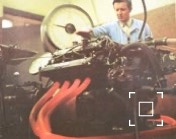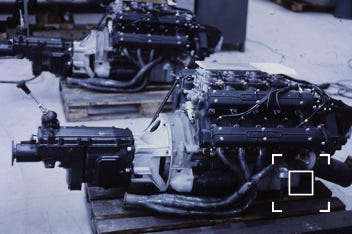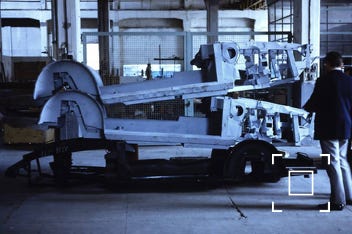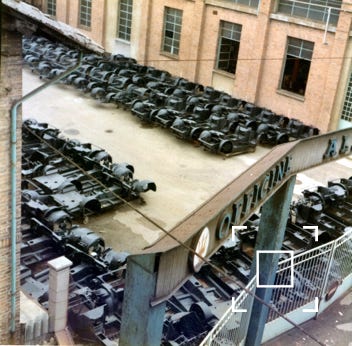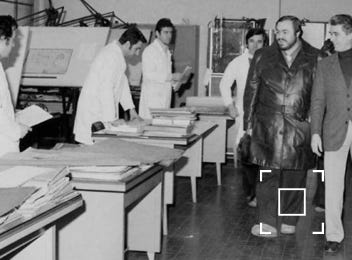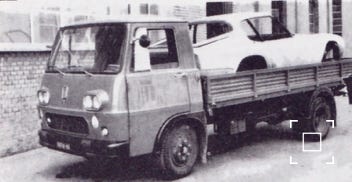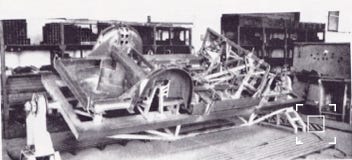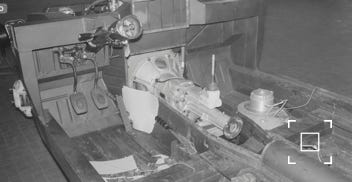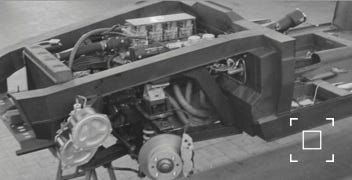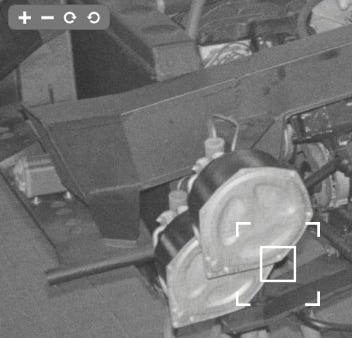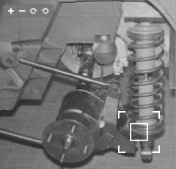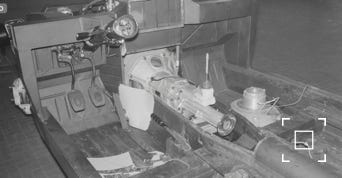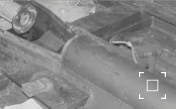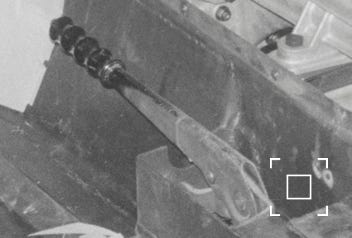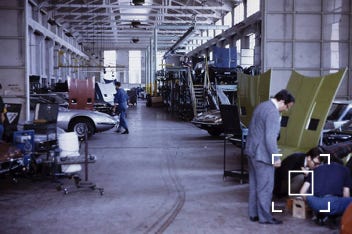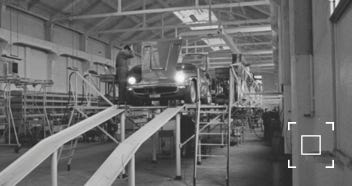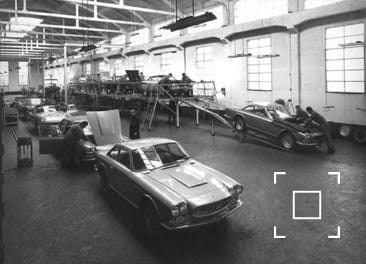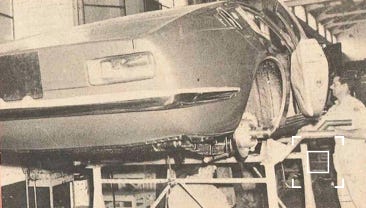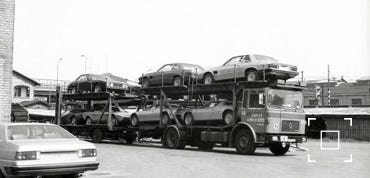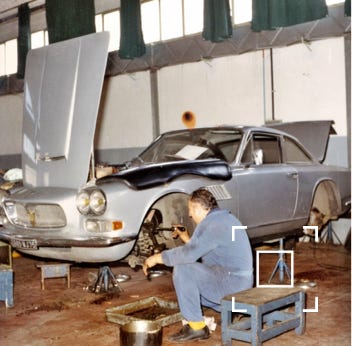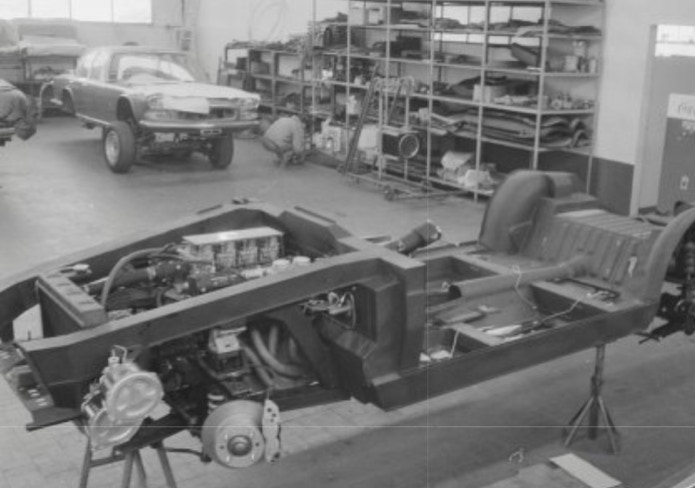
Production
Chassis under construction
Production figures
Thanks to further research by Maserati archivist Fabio Collina, who gave the number of 763 cars in an interview in 2013, confirmed in 2020 the number of Quattroporte AM 107 being built with 762, although on his list for sales by country, they add up to 763, a number we take as the official one. Incorrect numbers have been around for a while: In an article in Auto d‘Epoca, April 1997, the total number produced was given with 679, according to the Archivio Storico Maserati, while the number 759, given in the first Rob Box/ Richard Crump book in 1977, was nearly spot on. In Maurizo Tabucchis book, published in 2003, the number was 797, but there was most probably a confusion about the 1966 cars (series 1 and series 2 ). The first prototype was built in March 1963, the first production car was delivered in July 1964, the last one was delivered in November 1969. The following numbers by years are not confirmed, but appear to be quite accurate (sources: Tabucchi/ de la Rive/Crump/own calculations.)
Series I
1963 2 (#002 and #004)
1964 82
1965 148
1966 27
Total 259
Series II
1966 86
1967 193
1968 141
1969 82
Total 503 (254 Series 2, 250 series 2 1/2)
Total I+II 762
Series II: even numbers from 107.1000 - 107.1500 (250 cars) plus #1532, #1542, #1960, 253 cars in total (#1532, #1542, #1960 may also be series II 1/2). The first Series II car was presented May 30 1966 (Zagari, p. 801, X442), the series was built from that date to about August 1967.
Chassis numbers
Series I: even numbers from 107.002 to 107.520 with the exception of #418 which was not produced, therefore 259 cars. Two prototypes were built by Frua, 107.002 and 107.004.
Serial production of the series I cars started in July 1964, and ended in May 1966.
Series II 1/2: even numbers from 107.2000 to 107.2500 (250 cars). Built from August 1967, the last car was delivered in November 1969.
The manual for the series II cars refers to some detail changes from #1412 (manual version 1) or October 1968 (manual version 2). Indeed, the changes made for the 2000 series (see Evolution) and the 4.7 litre engine were presented in October in Earls Court and November 1968 in Torino.
Body numbers
All cars sport a body number, to be found under the bonnet, at the front next to the radiator, but the number is also to be found on all or most parts made by the carrozzeria. These are odd and even numbers (we assume 1 - 257 for series one, if not more than the two first cars have been produced by hand by Frua), 258 - 513 for the second series and 511 - 761 for the series II 1/2.
The first two cars were prototypes, definitely built by Frua, probably with no body numbers. At the beginning of production, it seems that the chassis production was in advance as Vignale only started to produce the bodies from mid-July 1964, early body numbers tend to be by a figure of up to 10 apart from the chassis numbers (Vignale first wanted to produce only cars under his own name, but realised that he still depended on orders). There are some differences from very early cars to later cars (bootlid, for instance, has a more handcrafted feel, and is in aluminum). At the start of the production, the bodies were attributed completely out of chronological order. The car which should have received body number 4 (chassis #008) received body #83, #034 should have received #17, it received body #2, chassis # 044 received body #11 instead of #22. The production sheet of these cars mainly show production dates of October 1964 until the beginning of 1965. We can assume a lot of chassis stocked somewhere in the factory (maybe even outside in the rain), waiting to be married to the bodies. After about 100 cars produced, the number of bodies got more or less in line with the chassis numbers: The 162nd produced car (chassis #324) received the 158th produced body, the 235th car received body #232. In the second series, Vignale and Maserati produced in harmony (just in time): the 324th car received the 324th body, the 351st chassis the 351st body. Throughout the rest of the production, body and chassis numbers didn‘t differ very much any more. We can assume that Maserati ordered batches of 250 bodies from Vignale. After they realised that demand was strong enough for a second batch, they ordered a second one. And, still gong strong, they ordered a third batch of 250 for 1968/69. The production started in mid-July 1964 with about five cars per week (they were rushing to satisfy demand which had built up for nearly a year), the first car was delivered July 21st 1964. Production came to a more leisurely pace:
By the end of 1967, Vignale built 6 to 7 Mexico and Quattroporte per week, if half of them were Quattroporte, then we have a yearly production of about 150 - 180 cars (which is according to the figures stated in the list above). But when Maserati was taken over by Citroen, the new owners didn‘t want to continue the production. The reason? Too costly to produce? Too similar to the more modern and equally 4-seater Indy? Plummeting demand (as there were now other fast 4-door saloons available: Iso Fidia, Jaguar XJ6, Mercedes 300 SEL 6.3)? New legislation (especially in the USA, Maserati’s new target market)? Production stopped in autumn 1969, the last car being delivered to Germany in November 1969.
4.7 Litres
According to the Maserati archives, there have been 73 Quattroporte 107 built with 4.7 litre engine, 8 as series I, 65 as series 2 (most of them as series 2 1/2 ).
3 cars have been built with a 4,9 litre engine (second series), one of them being #2326, now in the Maserati collection. The 4,7 litre was available for the first series, but became an official option only from October 1968, presented at the London Motorshow in October 1968 (according to Automobil Revue, 24.10. 1968. The article claimed that the 4,7 was now standard, and the 4,2 only available for the Mexico. But the 4,2 was clearly still available).
Borg Warner Automatic Transmission
According to an article in Automobil Revue, 11/1965, an automatic version had only been recently introduced, so first automatic cars maybe built in September 1965? Automobil Revue Katalognummer from March 1964 already lists the automatic gear box as an available option. And in Maserati’s sales brochure, the automatic is mentioned as an option too. We can assume that the automatic was available from the start, but nobody opted for it before late 1965. First automatic car registered is #330 from February 1966, only two Series I automatic are registered so far. Fabio Collina, Maserati’s historian, indicates the number of cars built with automatic transmission as 55, not distinguished between series 1 and 2. Automatic transmission is more often to be found on later cars /4.7 cars.
ZF Power Steering
Most early cars had no power steering, practically all cars with automatic transmission had it. It added 20 kg to the total weight.
Air condition
The Quattroporte series II was the first European car with air condition as standard. But already two thirds of all series I cars were so equipped. Often, the A/C was included in the sales price, so the dealer didn’t need to give a discount.
RHD
Only 33 RHD cars were built (Autocar claimed in 1966 that 30 RHD have been produced so far, maybe just a misinformation). 43 cars have been exported to RHD countries, ten LHD cars delivered to RHD countries, like 2086, a LHD car that went to Malta. Many Japanese buyers like to buy LHD cars (while in Australia, RHD was mandatory).
1. Italy: 493
2. Switzerland: 49
3. France, USA: 45 each
4. Germany: 31
5. United Kingdom: 29
6. Spain: 18
7. Netherlands: 9
8. Belgium, Japan: 7 each
9. Sweden: 5
10. Australia 4
11. Portugal: 3
12. Canada, Libya, Mexico: 2 each
13. Dominican Republic, Ireland, Lebanon, Luxembourg, Malta, Marocco, Norway, South Africa, Soviet Union, Thailand, Venezuela: one car each (12 in total).
First Owners
Many of the first owners were famous, all of them wealthy. Indeed, you had to be quite rich to afford a new Quattroporte in the 60ies. The market for luxury cars was much smaller then than it is now, because there were much fewer rich people around than today. World‘s wealth has tremendously increased over the last years. Back in the sixties, there were no millionaires in China (and only 20 years ago, in 2003, there wasn‘t a single billionaire – now there are over 300!), and the only Russian who owned a Quattroporte was president Leonid Brezhnev. Nowadays, the luxury car segment is huge. And Maserati has become a mass producer: By today‘s production figures, it would take them hardly more than a couple of weeks to grind out the whole Quattroporte production of 1964 - 1969. Not surprisingly, the list of Quattroporte I owners includes heads of industry and heads of states, princes, film stars, ambassadors... For instance #494, a car which was bought indirectly by Leonid Brezhnev. Or Prince Rainier‘s car, #376. The Aga Khan had at least five (!) Quattroporte. The King of Saudia Arabia, Princess Margaret of England, Count Giovanni Volpi di Misurata (owner of the Serenissima Racing Team and founder of ATS), Prince Ruffo di Calabria and many other noblemen. Marcello Mastroianni had two, and so did Peter Ustinov. Stewart Granger had one, as well as Alberto Sordi, Claudia Cardinale, Anthony Quinn, Sofia Loren, Sergio Leone, Mario Cecchi Gori (another Italian Film producer), Nino Benvenuti (Italian boxing hero).
Sales by countries
Markets
Ermanno Cozza, the first historian of Alfieri Maserati spa, once said that 70% of all Maserati Gran Turismo were sold in Italy. Indeed, this also applies to the Quattroporte AM 107, as nearly 65% of the production was sold in Italy (493 cars). Biggest export market was Switzerland – it also had the world’s highest number of new Quattroporte 107 per head! At the time, the USA was not such an important market, this came later with the Quattroporte III. Bob Grossman, official US-Maserati importer from 1968, claimed to have imported 15 Quattroporte only and that he imported 75% of all the new Maserati in that time. The rest, together with earlier Quattroportes (30, as the total number was 45) were either imported through dealers directly from the factory or by their first owners, mostly on an Italian EE registration. Some American customers also registered their cars in the country of purchase, and imported them as second hand cars. The official figure from the Maserati archives for the USA is 45, a mere 6,2 % (a decade later, the USA bought nearly 50% of the QP III production!). Cars for the US market differ only in very few details, most visible the speedometer in miles/h and the instruments in English (for non English-speaking markets, including France and Germany, the instruments were lettered in Italian). First series delivered originally to the USA had to have round headlamps (like all series 2 cars).
Prices
In 1964, the Maserati Quattroporte cost (in the UK) 5783 £, 200 £ more than a Rolls Royce Silver Cloud. In Switzerland, a neutral market, where prices are comparable and not distorted by custom duties for foreign cars in order to protect the local car industry, in 1964 the Quattroporte cost 48 900 Swiss Francs, the most expensive Maserati, the 5000 GT sold at 61 000 Francs (Alemanno), a Silver Cloud was 67 700. In 1966, the Quattroporte was the most expensive Maserati, priced at 51 000 CHF (or, historically correct, before the ISO norms, Sfr.), the same price as the Lamborghini 400 GT. The most expensive Audi (the Audi De Luxe) was, at 10 950 Sfr., nearly five times cheaper. And because depreciation was exorbitant, exotic car ownership was even more expensive. It‘s not uncommon to see those cars lose 90% of their value in the first five years! (This happened also to Ferraris, Aston Martins, Lamborghinis... by the way: a Ferrari 275 GTB was 2 000 Sfr. cheaper than a Quattroporte. And in the early seventies you could buy a second hand GTO for a third of the price of a new Quattroporte.) Although Maserati installed a cheaper rear suspension for the 1967 model year, the price increased to 53 200 Sfr. in 1967. But at a second glance, the car did indeed become slightly cheaper, because this price increase hardly reflected the inflation rate which amounted to 4.6% in 1966 and 3.5% in 1967. In the UK, the official Maserati price list listed the Quattroporte at £6960 incl. taxes, while Mexico and Ghibli were remarkably more expensive, at £7893 and £8237 respectively. The Swiss prices in the same year were 58 900 fro the Mexico 4.2, 63 000 for the 4.7 and 66 500 for the Ghibli.
In 1969, the Quattroporte was still 53 200 Francs while the price of the 4.7 litre version wasn‘t yet listed in the catalogue of the Automobil Revue, but cost 3 500 Francs more. Before spring 1969, no 4.7 litre version was listed at all. In Italy, the Quattroporte, in the last year of the Series I, cost 5.800.000 Lire, in the same year, the new series II cost 6.300.000, some 8% more.
Body production
The prototypes (004 and 002) were built by Pietro Frua, maybe with the help of O.TO. CAR (Officina Torinese Carrozzeria, Torino) or Maggiora (the company which produced certainly the Mistral bodies, also designed by Frua). There is a body number to be found on the cars, attributed by the Carrozzeria which produced the bodies. The serial bodies were put together at Vignale, the serial bodies were mainly made by Maggiora, with parts from O.TO car, as they were involved in the deal: According to Alfredo Zanellato Vignale, nephew of Alfredo Vignale, it was Gino Molino, head of O.TO.CAR, who had arranged the contract between Maserati and Vignale, as he knew that Frua was too small to produce in larger numbers. Vignale was at first reluctant to sign, he would have preferred to produce only cars bearing his name, but he also had ends to meet, and so he gave in.
According to an article in Automobil Revue, July 2nd 1964, Vignale was to start production „in a few days, to the rate of 1 car per day“. The first car (107.042) was finished on the 21st of July 1964, delivered a few days later to Martinelli & Sonvico, the Swiss importer.
Unfortunately, I have no picture of a Quattroporte under production at O.TO.CAR, Vignale or Maggiora but there are some pictures of other Maseratis at O.TO CAR. Vignale had some other subcontractors, we can assume that the upholstery was done by Manzon & Bertolotti, chrome trim and grill by Cellino, chrome plating by Corio and metal pressing by Ellegi, if not by O.TO.CAR. And if the cars were not painted at Vignale‘s, then they were at a Company called ARCA. All these companies were geographically close to Vignale‘s new premises in Grugliasco/Torino.
Some sources claim that coachwork had been delivered by Carrozzeria Padane (they indeed did Indys) or even Carrozzeria Marazzi. But as Marazzi was founded (on the remains of Touring) only in late 1966/early 1967, this seems like science fiction: Maseratis were fast, but never fast enough to travel forward in time...
Chassis production
The chassis was produced by Forghieri in nearby Maranello. According to Forghieri, now a producer of cabins and tempered glass, Commendatore Orsi entrusted them the construction of all the Maserati chassis, from the end of the 1950s on, this allowed Forghieri to „significantly increase its work, to expand and renovate the plant“.
Body parts
The Tipo 107 is in most parts a hand crafted car. Most body and trim parts were stamped with the body number. Part equality was not a given: Every craftsman had probably slightly other methods of working the metal (an other enthusiast, knowing Italian mentality, called them „Friday afternoon rules of construction“: “Non e lo stesso, manca un centimetro, ma non importa, va bene così, e ora di tornare a casa“. ) This means for the restorer that often frustrating adaptive work has to be undertaken to make parts fit. If you tackle a Quattroporte restoration, to have matching body parts is much more important than to have a matching chassis/engine number combination. Vignale used odd and even numbers for bodies, Maserati used only even numbers for chassis and engines. Therefore, if a car sports a body number like 200, the chassis number is likely to be around 107.400. Body numbers 1 to 250 are likely to be 1st series (1 to 250), second series: 251 to 500; Series 2 1/2 : 501 to 750. The Maserati factory in Modena was much more of an artisanal manufacture then than now. Maserati mainly only built the engine. Gearbox came from ZF, rear suspension from Salisbury, brakes were Girling, A/C by York, etc. Other items, like ashtrays in doors (BMW) came from other manufacturers, switches were used by Alfa Romeo as well, the lights for the illumination of the numberplate was by Hella and used for the Porsche 356, first series front lights were sourced from Citroën (Ami 6). At Maserati, the parts were assembled and the chassis mated to the body. Then followed a test drive and the transport to the concessionaire, which was for about 70% in Italy itself. (In much of a difference to Ferrari, where about 70% stood for the exported cars in that era.)
Pietro Frua, the designer. More about him here
Ing. Giulio Alfieri (right) and Omer Orsi, engineer and owner
Alfredo Vignale, at the time the Quattroporte was being built in his factory
Frua's Atelier in Borgo San Pietro-Moncalieri (Torino), now abandoned
Quattroporte prototype (004) in Front of Frua's workshop. Still as a mock up, without engine
Frua‘s Studio, abandoned, drawing table on the floor
Frua at work on a prototype (5000 GT, 064)
Frua at work on 5000 GT (064)
Frua most probably worked in the same way on the 107 prototype
One of the many blueprints it had taken to construct the Tipo 107
Frua‘s proposal in form of a 1:8 plaster model
Was Frua really proposing a break variant of the 107?
Frua’s first drawing, different to production model
Entrance to Vignale factory 1965
Vignale, Brochure
Vignale factory, Strada del Portone, Grugliasco, Torino, built in 1961
Vignale, prototype department, 1964
Vignale Trimshop
Vignale, paint shop, 1964
Vignale, Body shop in 1964
Assembly line at Vignale in 1964, shortly before Quattroporte production began
Assembly line at Vignale in 1964, shortly before Quattroporte production began
Assembly line at Vignale in 1964, shortly before Quattroporte production began
Assembly line at Vignale in 1964, shortly before Quattroporte production began
Production at Vignale 1961-1963 Vignale Spyder in foreground, 600 Vignalina in background
Vignale production, 1964. Quattroporte production started soon after this picture was taken, in July or early August 1964
Vignale production, 1964.
Vignale factory in 1966 (here producing Jensens)
Maserati Sebring (by Vignale) under production at O.TO.CAR. On the right hand side the Vignale Fiat 1500. Seems like Vignale didn‘t even have the capacities to produce the cars bearing his own name
Maserati chassis and bodies under construction at O.TO.CAR in Torino. This was a much more industrialised procedure as you may have suspected
O.TO Car, Torino, Vignale Fiat 1500
Not all panels were beaten by hand at O.TO.CAR...
The Merak had been produced at O.TO.CAR, too. Today, the company is producing tooling machines
On the 107, the VIgnale tag sits in front of the engine and is painted over. Here body # 552.
On the 107, the VIgnale tag sits in front of the engine and is painted over. Here body # 390.
Vignale body number, early Sebring, unpainted
Every part was stamped with body number
Every part was stamped or signed with body number
Every part was stamped with body number, here 549
Every part was signed with body number, here 201, chassis #406
Every part was stamped or signed with body number, here 201, chassis #406
Parts from different bodies don‘t necessarily match, as seen here
Parts from different bodies don‘t necessarily match, as seen here
Vignale tag hanging on the body, reverse side
Vignale tag hanging on the body, front side
Factory gate
Entrance to Factory, 1967
Factory yard, mid sixties
Drawing departement
Engine department
Engine department
Engine department
Engine department
Working on engine, 1967
Working on engine, 1958
Working on engine, 1967
Craftsman working on engine, 1970
Engine production, ca 1970
Working on engine, 1978 (no difference to 1967 or 1958...)
Working on an engine (1957), racing department. Work in 1967/78 didn‘t look much different
Engine production, 1970
Later engine (ca 1977), but it wouldn't have looked much different in the 60ies
Engine on brake, here in 1978
Engine test, 1960ies
Engine on brake, 1970
Engine production, ca 1970
Engines awaiting installing, here Ghibli
Engine production, ca 1970
This is how chassis were delivered, here two Indy chassis and one Ghibli
Overhang of chassis, mid 1970ies.
Chassis department
Construction department in 1977 (Pavarotti visiting). It looked the same in 1967... or in 1957...
This is how bodies were delivered, here a Mistral
Bodies being prepared to mate with mechanicals (here Mistral)
Reparto telai, chassis department, (here: Mistral)
Chassis workshop/assembly. In background, a car being repaired
Car being repaired at the same place as new chassis made made
Assembly (1st series)
Assembly (1st series)
Assembly (1st series)
Assembly (1st series)
Assembly
Assembly
Assembly
Assembly
Assembly
Assembly
Assembly
Assembly
Assembly
Assembly
The bodies, delivered by Vignale, were moved inside the factory by the works tipper truck (here a Ghibli, delivered from Ghia)
Maserati factory (final assembly, end of line, G. Bertocchi and O. Orsi)
Production line in 1970, Quattroporte out of production
A Quattroporte coming off the line. Production of about 3 cars per week from 1964 to1969
Maserati factory (final assembly, end of line), here a Mistral. All models were assembled on the same line
Maserati factory (final assembly, end of line)
Maserati factory (final assembly, end of line), here with a Ghibli 1967
Test drive, 1964
Test drive, 1964
Cars awaiting picking up from customers in front of the factory
Car transport leaving Maserati factory in the early 1980ies, hardly any different to the late 1960ies.
Car was delivered with dealer‘s paraphernalia
Maserati also had a service department. Some customers preferred having their cars serviced at the factory, here a Sebring coming all the way from Paris
Service department, maintenance work on a ZF gear box - but of which type?
Service department in 1970ies, work on a 6-Cyl.-camshaft. The service department was open to clients until 1989.
